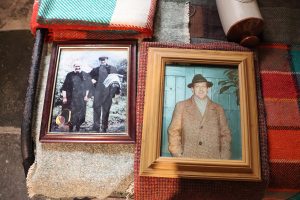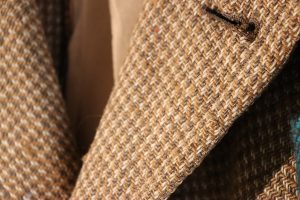The Tweed Suit: Week one. Part 1, 2 and 3
Part 1. The Tweed Suit. Finding a way into the past, to this place, through its cloth. It’s 2022, I’m researching in Glebe House, once owned by the artist Derek Hill. Photographing potential locations to place my work. I notice the Tweed suits hanging from the bed frame. This takes hold of something in me. We speak about Cottage Tweed and cloth woven in the homes of people across Donegal. Soon I’m remembering this suit – the pattern, the colours – the cloth appeals to me. Hearing that Derek Hill bought this cloth locally from a Cottage Tweed weaver, gives me evidence of a local industry. Imagining cottages, weavers, hand-woven cloth, looms, each cloth connected to that weaver. Thinking about Derek Hill visiting this particular cottage to purchase the cloth directly. Getting closer to this cloth by copying the pattern in paper collage, then remaking this copy in textile.
Pausing to go back to the beginning.
~ ~ ~
Image 1: The Tweed Suit photographed in Glebe House in 2022.
Image 2: Studies of Donegal Tweed in paper collage, 2023, LMcC.
Image 3: Studies of Donegal Tweed, textile, 2023, LMcC.


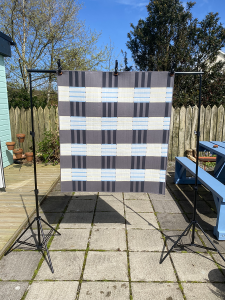
~ ~ ~
Part 2. The Cottage. It’s 1 September 2024 I’ve arrived at the cottage of Weaver Manus Ferry. Excited to be in the place where that cloth for Derek Hill’s Tweed suit came from. Entering the cottage feels significant, like coming back to something familiar. Sitting at the loom brings me closer. It’s 1901, this cottage comprises of the father John, 36, mother Mary, 40 and seven children. Manus is 12, can read and write and is at school. Ten years later in 1911, Mary is now a widow, raising the family. Manus, 22, is a farm labourer, living at home with his mother and three siblings, Michael, 24, Sophia, 13 and Patrick, 18. His mother is a crofter farmer and his brother Patrick is a Herd. They are all speak Irish and English. So when does Manus become a weaver?
~ ~ ~
Image 1: Manus Ferry portrait taken in the Ferry cottage, Ionad Cois Locha, Dunlewey Centre.
Image 2: Manus Ferry, Loom (detail), Ionad Cois Locha, Dunlewey Centre.
Image 3: Manus Ferry, Loom (detail), Ionad Cois Locha, Dunlewey Centre.
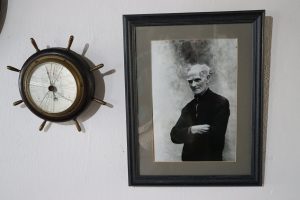
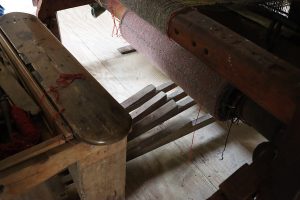
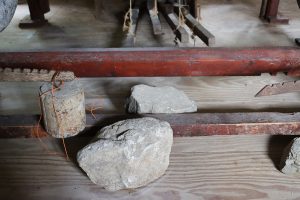
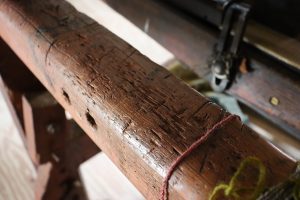
~ ~ ~
Part 3. The Weaver and the cloth. It’s the 1950’s, Weaver Manus Ferry, is known for his Cottage Tweeds. People come to the cottage to purchase his cloth. Including local landlords of vast estates, Henry McIlhinney, owner of Glenveagh Castle, Sir Sidney Nolan, a famous Australian artist, Derek Hill and many others. His brother Patrick, provides the wool from his sheep that graze in the surrounding mountains. Both weaver and shepherd, live with their sister Sophia, who runs their shop and household. The three will remain together in this cottage, for the whole of their lives.
It’s 4 May 1992, the homestead is purchased by the local community, to preserve the cottage and the story. Manus wove twelve hours a day to make his famous Tweed, which ended up in “all corners of the world.” This place had faced “utter destitution of this beautiful area under colonial rule.” (Ionad Cois Locha), with the community surviving famine, eviction, the importation of Presbyterian shepherds from Scotland to take over the mountains, and mass emigration.” (1996, Irish Times, Breathing Life into the Landscape)
This brings up wider questions about this cottage industry in Donegal. A name that comes up is Alice Hart (1848-1931), an English philanthropist, artist, business woman and doctor from London. I’ll return to Alice.
~ ~ ~
Image 1: Framed photographs of Sophia and Manus Ferry and Henry McIlhinney, wearing the Tweed coat, now on display in Ionad Cois Locha, Dunlewey Centre.
Image 2: The Tweed coat woven by Manus Ferry and owned by Henry McIlhinney. Photographed in Ionad Cois Locha, Dunlewey Centre.
Image 2: Photograph of Sophia, Patrick, Manus (L-R), taken on front of their green tin shop.
